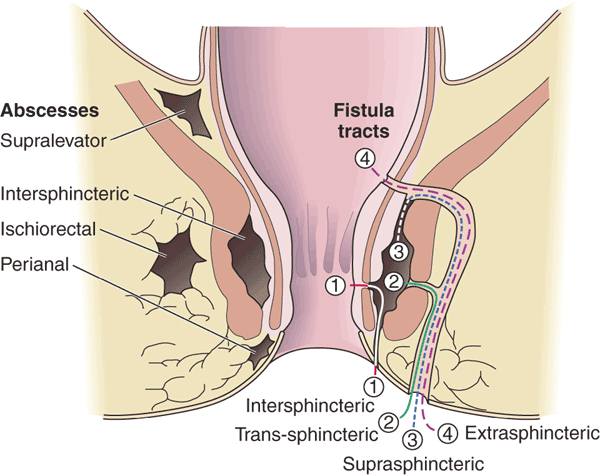Fissure in ano / FistulasWhat? An ano rectal fistula (Fistula-in- Ano) is an abnormal communication between the anus and the perianal skin. Anal fistulae originate from the anal glands, which are located between the two layers of the anal sphincters and which drain into the anal canal. If the outlet of these glands becomes blocked, an abscess can form which can eventually point to the skin surface. The tract formed by this process is the fistula. Abscesses can recur if the fistula seals over, allowing the accumulation of pus. It then points to the surface again, and the process repeats. Anal fistulas per se do not generally harm, but can be very painful, and can be irritating because of the pus-drain (it is also possible for formed stools to be passed through the fistula).Abscesses can recur if the fistula seals over, allowing the accumulation of pus. It then points to the surface again, and the process repeats.
There is usually a history of one of the following like ano rectal abscess which is the most common cause, piles, fissures, constipation, crohn’s disease, carcinoma etc. The dentate line is the borderline between the anus and the rectum, and it is very painful when bacteria enter from the area it caves inward, suppurates and produces abscess (accumulated pus). It is called anal fistula when the accumulated pus spreads around, breaks the skin and discharges pus, the hole the breaking made does not close up, and forms a pipe linked to the inside of the anus.
1) Low level fistulae • Subcutaneous 2) High level fistulae • Pelvi rectal
Anal fistulae can present with many different symptoms: • Pain, which is usually constant, throbbing and worse when sitting down
Diagnosis is by examination, either in an outpatient setting or under anaesthesia (referred to as EUA — Examination Under Anaesthesia). The examination can be an anoscopy. Possible findings: • The opening of the fistula onto the skin may be seen
• Probing
Homeopathy can help alleviate an abscess in the anal fistula as it is a non-intrusive and safe remedy. Since homeopathic medicines utilize the body’s own defences to fight the pus in the anus, this line of treatment is natural and non-toxic as compared to other cures.Invariably patients come to a homeopathy doctor after many years of suffering and sometimes after going through multiple surgeries.The medicines will first work to control the infection in the area thereby preventing attacks of the abscess formation. Later, the remedies will start new tissue development to close down the tract. When the process of redeposit is complete the opening closes down and the anorectal fistula is cured permanently. This is a prolonged process and the time required varies from person to person, depending on the length and depth of the tract. |
Contact Us
|




